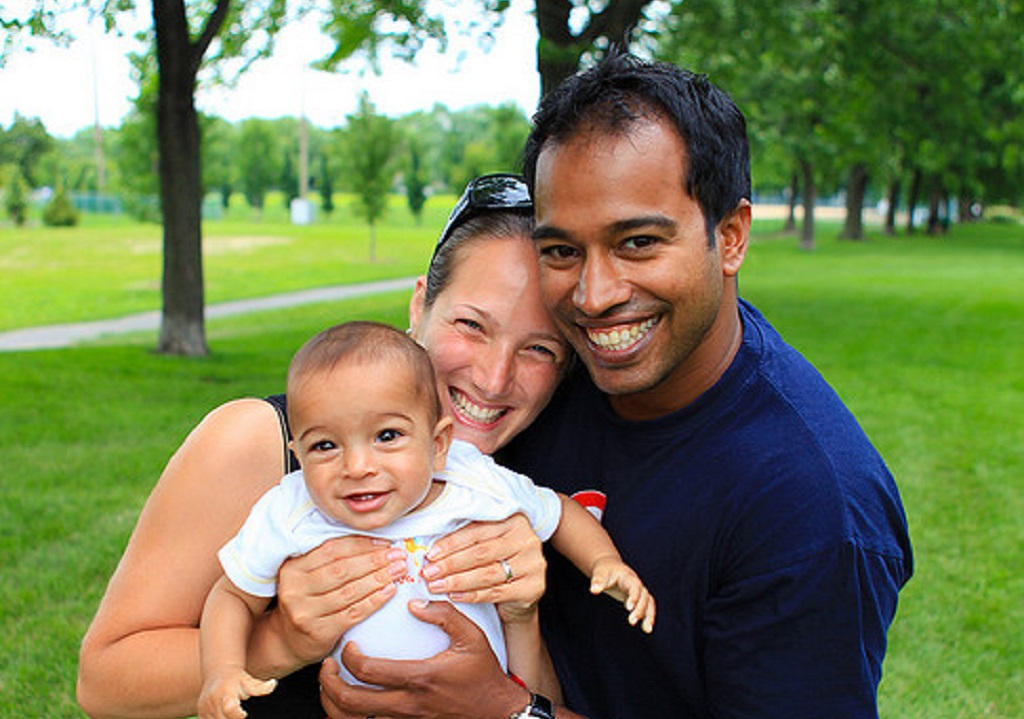What Is the Percentage of Married Couples Who Have a Baby in the First Year

What Happens When Couples Ally after the First Infant?
A briefing paper prepared for the Council on Gimmicky Families by Kelly Musick, Cornell Academy and Katherine Michelmore, Academy of Michigan
September 16, 2015
One of the consistent findings of sociological inquiry in recent decades has been that couples who had a child before getting married had substantially college odds of divorcing than couples who married first. This held true even when researchers controlled for other factors that tend to distinguish such couples from those who marry straight—education, family unit background, race and ethnicity. Only because the tremendous increment in premarital cohabitation and childbearing over the past quarter century, and in light of new show that many other longstanding "laws" of marriage and divorce have been overturned (eastward.m., see "It'southward Non Only Attitudes: Marriage Is Likewise Becoming More Egalitarian"; Are Individuals Who Marry at an Older Age Too Set up in Their Ways to Make Their Marriages Work?), we set out to investigate whether this item sociological "rule" notwithstanding applies.
We used big-scale data from the 1995 and 2006-2010 National Survey of Family Growth (NSFG), which asks women of childbearing age questions well-nigh relationships and family formation. We analyzed all marital and cohabiting unions in which a child was born inside 10 years of the surveys (i.e., between 1985 and 1995 in the earlier catamenia and 1997 and 2010 in the subsequently period). We ended upward with a sample of two,656 couples from the 1995 NSFG and three,046 from the 2006-2010 interviews.
In the earlier flow, for births occurring between 1985 and 1995, 17 percent of the couples we studied had a child earlier marrying. Of these, 21 percentage married inside a year, and 59 percent of those even so together went on to ally inside 5 years. In the subsequently flow, for births occurring between 1997 and 2010, 35 pct of the couples nosotros studied (fully twice as many as a decade earlier) had a child together before marrying. This time a smaller but however significant percentage of such couples later married: 15 percentage did so within a year, and 48 percentage within 5 years.
In the 1995 sample, equally researchers had long warned, couples who lived together, had a premarital nascency, and later went on to marry were more than than 60 percent more likely to divorce than couples who married before having a child. But just a decade afterwards, couples who lived together, had a kid, so went on to marry after the nascency of their starting time childhad no higher chance of breaking upwardly than couples who married without ever living together first or couples who lived together only married before having a kid.
In each case, we controlled for socio-demographic factors that correlate with differences in marital behaviors and the risk of divorce. Decision-making for these factors, we constitute that the hazard of divorce for couples who wed after having their first child exterior marriage was no longer any higher than for couples who lived together but married before having their first kid or for couples who never lived together at all before getting married and starting a family.
The only cohabiting parents with significantly higher chances of breaking up were those who never married. Once again decision-making for socio-demographic factors, we found that near thirty percent of couples who never married separated within five years, a breakup rate twice as loftier as that we found among the married. This is a disturbing finding in terms of kid outcomes, because nosotros know that family unit instability is a risk factor for children.
It is not at all articulate, however, that if we could magically assign these cohabiting couples to ally, their family relationships would exist more stable. In general, cohabiting couples tend to have less teaching and income than married couples, and it may be that those who exercise not marry are a peculiarly disadvantaged group (for example, we could not business relationship for the job prospects of male person partners). Such couples may also have relationship issues (substance abuse, infidelity, or domestic violence) that explain why they do not get married, and that would non be solved by giving them a marriage license. Marriage is less a silver bullet than information technology is an consequence of a whole gear up of factors linked to stability and security that assistance parents stay together. The stark and growing differences in divorce risks between couples with little education and those with a college degree undermine the notion that marriage itself tin solve the bigger problems that stem from economical dubiousness and inequality (e.thousand., see "The New Instability"; Labor'due south Dearest Lost).
Implications
Our research addresses the potential bear on of ascent childbearing among cohabiting couples—and in the process sheds new calorie-free on the evolving meanings of matrimony and cohabitation in the U.Due south. Past looking closely at changes in parents' unions around the time of childbirth, nosotros found that premarital births no longer predict breakups, as long as couples marry at some point later a child is built-in. Simply much nevertheless remains to be learned about the causes and consequences of persistent family unit instability when parents never ally at all.
This conference newspaper highlights some of the findings of a much longer study by Kelly Musick and Katherine Michelmore, "Modify in the Stability of Marital and Cohabiting Unions Post-obit the Nascence of a Child," forthcoming in Census.
For farther information, contact:
Kelly Musick
Associate Professor of Policy Analysis and Management
Cornell University
musick@cornell.edu
607-255-6067
Katherine Michelmore
Postdoctoral Fellow
University of Michigan
kmichelm@umich.edu
734-615-3802
Source: https://sites.utexas.edu/contemporaryfamilies/marriage_timing_doesnt_matter/
Post a Comment for "What Is the Percentage of Married Couples Who Have a Baby in the First Year"